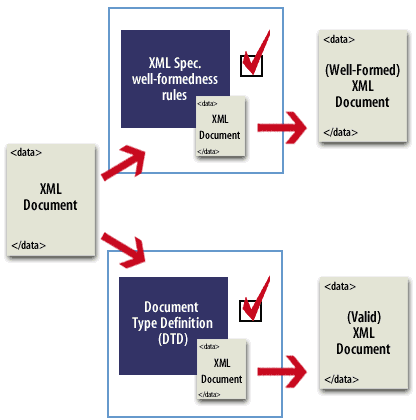| Lesson 2 | Requirements for XML documents |
| Objective | Describe the Concepts of well-formedness and Validity |
Describe Well-formedness and Validation Concepts
Creating XML Documents and Programming
The XML specification defines a set of rules that XML documents must follow in order to be well-formed.
If an XML document is not well-formed according to the XML specification, browsers, for example, should not make any attempt at correcting the errors as they did for HTML documents.
The inevitable result of browsers correcting HTML documents was the creation of many versions of HTML.
Well-formedness constraint
The following text demonstrates a complete, well-formed XML document:
<greeting>Hello, World!</greeting>
This XML document is not large, but it is error free.
For reasons of forward compatibility, one additional element is requested, but not required, at the start of XML documents: the xml declaration that specifies the version of XML to which the document conforms. The following example begins with an xml declaration providing version information.
For reasons of forward compatibility, one additional element is requested, but not required, at the start of XML documents: the xml declaration that specifies the version of XML to which the document conforms. The following example begins with an xml declaration providing version information.
<?xml version="1.0"?> <greeting>Hello, World!</greeting>
Requirements
What exactly is an XML document? Consider the definition from the W3C's Recommendation for XML 1.0.
Validity constraint
An XML document is valid if it complies with a Document Type Definition (DTD).
A DTD is a text-based file that specifies, among other things, which elements are used in an XML document. An XML parser will validate the XML document against the specified DTD and will generate errors if there are any inconsistencies.
A DTD is a text-based file that specifies, among other things, which elements are used in an XML document. An XML parser will validate the XML document against the specified DTD and will generate errors if there are any inconsistencies.
